
The Victor-Victrola Page

Victrola Design Details
1. Cabinets
2. Cranks, Brakes and Speed Controls
4. Lid Supports, Record Albums and Needle Trays
Pictures and details on some of the design features of Internal Horn Victrola phonographs. Each sequential page covers one aspect of the evolving designs. Advance to the next page via the link above or at the bottom of each page
Design Details: Lid Supports, Record Albums and Needle Trays
Victrolas used a variety of hardware designs to support the lids when open. Victor record albums were provided with most Victrolas, but were optional (at extra cost) with the low-priced models. The album designs changed over the years. Needle trays were used to store new and used needles.
Lid Supports
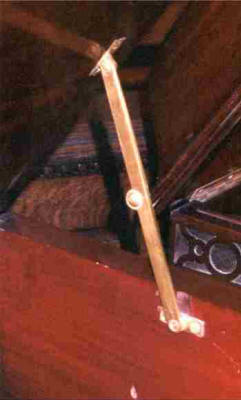 When
introduced in 1906, the earliest
flat-top "VTLA" Pooley Victrolas used a "pivot arm" or
Elbow Lid Support
mechanism,
which pivoted and locked at the
round center joint. With this design, the lid was either fully closed or
fully open, with no graduation. This design was used only for a few months
on the very first Victrolas.
When
introduced in 1906, the earliest
flat-top "VTLA" Pooley Victrolas used a "pivot arm" or
Elbow Lid Support
mechanism,
which pivoted and locked at the
round center joint. With this design, the lid was either fully closed or
fully open, with no graduation. This design was used only for a few months
on the very first Victrolas.
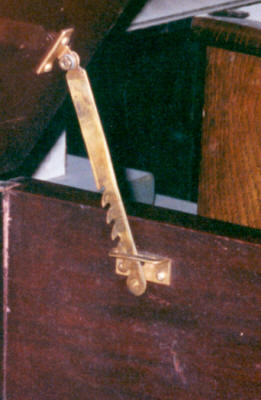 A
few months later,
the bending pivot was replaced with a Ratchet Lid Support,
which was used until the flat-top "VTLA" Pooleys were discontinued in early 1907.
On this design, the lid could be opened to several different positions,
rather than just the "fully open" position of the earlier design.
A
few months later,
the bending pivot was replaced with a Ratchet Lid Support,
which was used until the flat-top "VTLA" Pooleys were discontinued in early 1907.
On this design, the lid could be opened to several different positions,
rather than just the "fully open" position of the earlier design.
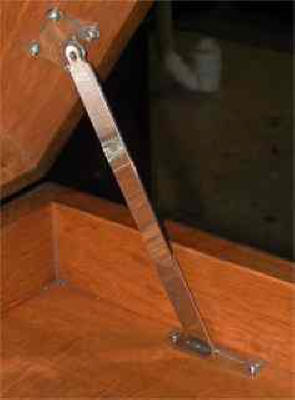 The
ratchet-lock was quickly replaced by a Sliding Lid Support
system when the dome-lidded Victrolas were introduced in 1907. This basic
mechanism was continued on all lidded Victrolas for many years. This system will
automatically lock the lid in the full "up" position when opening, but requires
that the support arm be manually pulled towards the user to close the
lid. The less expensive Victrolas used a simple external pin to catch on the
The
ratchet-lock was quickly replaced by a Sliding Lid Support
system when the dome-lidded Victrolas were introduced in 1907. This basic
mechanism was continued on all lidded Victrolas for many years. This system will
automatically lock the lid in the full "up" position when opening, but requires
that the support arm be manually pulled towards the user to close the
lid. The less expensive Victrolas used a simple external pin to catch on the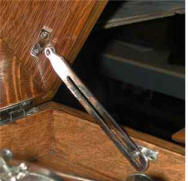 sliding arm's indent point (right), while the more deluxe models had the
catch built-in to a slotted cover (left), giving a neater appearance.
sliding arm's indent point (right), while the more deluxe models had the
catch built-in to a slotted cover (left), giving a neater appearance.
In 1923, Victor
introduced an Air Damper Lid Support system on its high-priced
models, wherein the user could simply lift the lid to automatically latch it,
and gently push it down to automatically close. This eliminated the need to pull on the
support arm to unlatch it. An internal damping cylinder allowed the lid to close slowly
without slamming. Since the mechanical components were internal to the machine
cabinet, this design appears almost identical to the earlier sliding latch
mechanism (above). This lid support system was offered on
some of the more expensive Victrolas up until 1928. In many cases, regular maintenance is required to
keep them operating smoothly, as the leather seals (internal to the air cylinders)
tend to dry-out over time.
In
1925, with the introduction of the Orthophonic Victrolas, several models
adopted a Spring Lid Support system. These were intended to
allow the easy opening and closing of heavy lids on the larger models, using
internal springs as a counterbalancing force. These systems worked smoothly
and required minimal maintenance. Some Orthophonics used the Air
Damper Lid Support, while the low-cost models continued to use the basic Sliding Lid
Support.
Victrola Record Albums
Victor produced many types of different book-style record boxes and albums over the years; only a few are covered here. High-end models were sold with the albums included. Less expensive Victrolas did not come with albums; they had to be purchased as an extra-cost accessory. Please note that many other companies manufactured their own "aftermarket" record albums, which were available at less cost through record stores. Victor's albums will always have either the "Nipper" logo, or written identification plainly visible on the inside or outside of the album covers. Albums came in 10" and 12" sizes, and most are labeled alphabetically on the ends, although unlabeled albums could be purchased as well. For a complete overview of Victor's albums, please refer to Bob Baumbach's "Victor Data Book", found in the RESOURCES section of this website.
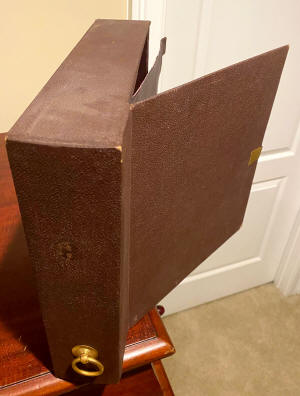 Dark
Red Box Albums These came as standard accessories on the very
first Victrolas (designated "VTLA") from the time of the machine's
introduction in the summer of 1906 up through early 1908, although they
continued to be available as a catalog item from dealers for another year.
A gold pull ring is used. No embossing or decorations are used on the
external areas of the boxes.
Dark
Red Box Albums These came as standard accessories on the very
first Victrolas (designated "VTLA") from the time of the machine's
introduction in the summer of 1906 up through early 1908, although they
continued to be available as a catalog item from dealers for another year.
A gold pull ring is used. No embossing or decorations are used on the
external areas of the boxes.
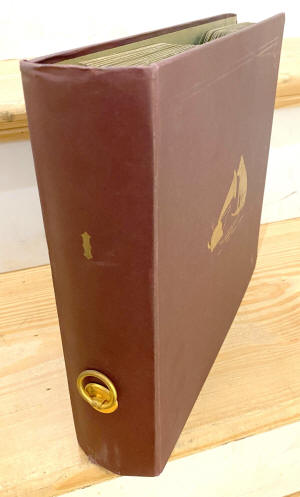 Dark
Red Albums with brass pull rings. Introduced in the summer of 1908, and
available until 1914, these albums were included with high-end machines such
as the Victrola XVI. The Victor trademark is embossed in gold on the front
cover
Dark
Red Albums with brass pull rings. Introduced in the summer of 1908, and
available until 1914, these albums were included with high-end machines such
as the Victrola XVI. The Victor trademark is embossed in gold on the front
cover
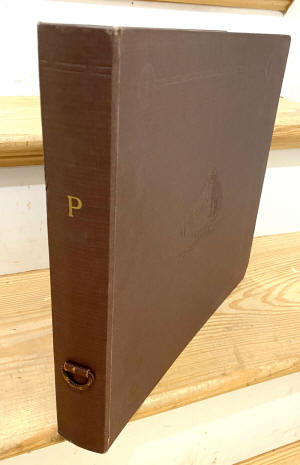 Maroon-Brown
Albums with half-ring leather 'pulls'. Introduced in the 1913
Victor catalog, these albums continued to be available until the Orthophonic machines were
introduced in 1925. The Victor trademark is embossed on the front cover. This
was the standard-issue album style for most Victrolas made during and after
1913.
Maroon-Brown
Albums with half-ring leather 'pulls'. Introduced in the 1913
Victor catalog, these albums continued to be available until the Orthophonic machines were
introduced in 1925. The Victor trademark is embossed on the front cover. This
was the standard-issue album style for most Victrolas made during and after
1913.
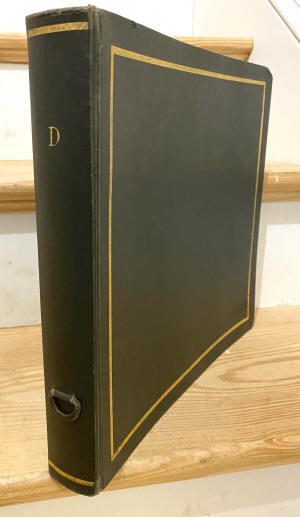 Dark
Green Albums with half-ring leather 'pulls'. These were provided
only for Victor's exclusive "Period" machines from 1917 through circa 1924.
The albums are trimmed with a gold border, and the Victor logo appears on
the front inside cover.
Dark
Green Albums with half-ring leather 'pulls'. These were provided
only for Victor's exclusive "Period" machines from 1917 through circa 1924.
The albums are trimmed with a gold border, and the Victor logo appears on
the front inside cover.
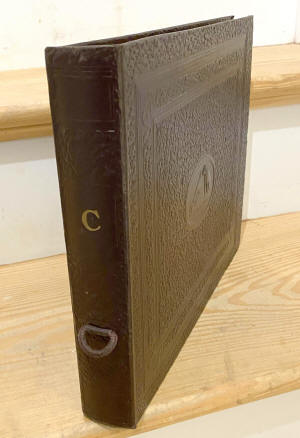 Glossy
Dark-Brown "Leatherette" Albums were introduced in 1925 for the
Orthophonic Victrolas. The Victor logo is embossed on the outside cover.
Several variations of this design exist.
Glossy
Dark-Brown "Leatherette" Albums were introduced in 1925 for the
Orthophonic Victrolas. The Victor logo is embossed on the outside cover.
Several variations of this design exist.
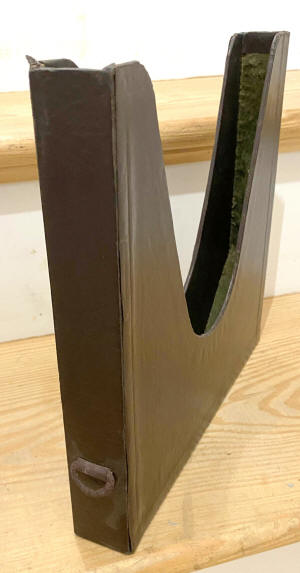 Dark
Brown "Half-Round" Albums were provided for some automatic record
changing Victrolas, such as the "VE 10-50" and "VE 10-51".
Several variations of this design exist.
Dark
Brown "Half-Round" Albums were provided for some automatic record
changing Victrolas, such as the "VE 10-50" and "VE 10-51".
Several variations of this design exist.
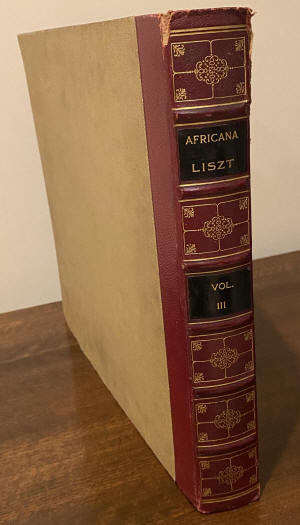 In
the late 1920's, Victor began using record albums with colored spines for
some of their upscale machines such as the "VV 8-35" and "VV
9-54". These came in three different colors with various titles,
usually correlating to the names of composers, musical works, or Victor's
major record artists.
In
the late 1920's, Victor began using record albums with colored spines for
some of their upscale machines such as the "VV 8-35" and "VV
9-54". These came in three different colors with various titles,
usually correlating to the names of composers, musical works, or Victor's
major record artists.
Needle Cups and Trays
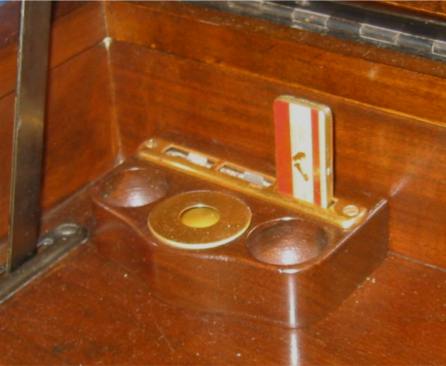 Most
Victrola machines have a "needle cup" near the motorboard, similar to the
one shown on the left. Loud needles go in one cup, soft needles in the other
and the gold or nickel center cup is where the used needles should be placed
(remember to discard the needle after each record is played!). When the
center cup fills-up with used needles, you remove the cup, twist-off the
lid, and simply dump them in the trash. It is humorous to note that many EBay sellers
seem to take great pride in the fact that their phonograph has 4 or 5 needles
still sitting in a cup. Those old needles have likely been used 20 times
each, and belong in the garbage. New ones are readily available for just a few pennies each. See our section on needles for more
information.
Most
Victrola machines have a "needle cup" near the motorboard, similar to the
one shown on the left. Loud needles go in one cup, soft needles in the other
and the gold or nickel center cup is where the used needles should be placed
(remember to discard the needle after each record is played!). When the
center cup fills-up with used needles, you remove the cup, twist-off the
lid, and simply dump them in the trash. It is humorous to note that many EBay sellers
seem to take great pride in the fact that their phonograph has 4 or 5 needles
still sitting in a cup. Those old needles have likely been used 20 times
each, and belong in the garbage. New ones are readily available for just a few pennies each. See our section on needles for more
information.
The "slots" in the back of the needle cups (on later-vintage machines) were used to hold the Tungstone needle tins.

